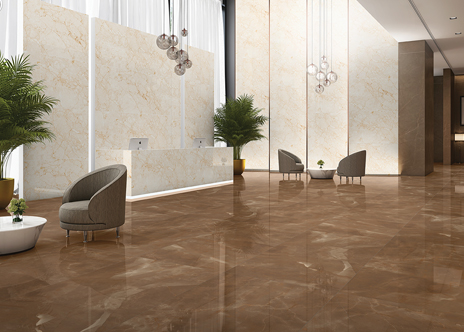
February 02, 2023
Flooring is the foundation of any beautiful room. So, it has a great importance in home décor, both literally and from an aesthetic point of view. From interiors to wall colours to furnishings, anything can be changed without much ado, but same is not applicable to flooring. The process of changing a floor is arduous and time-consuming, therefore it becomes important that you choose right flooring option for your house. Whether to go for a tiled floor or a marbled floor, is the biggest dilemma for Indian homeowners, and so we are here to ease your confusion!
Vitrified tiles are a mixture of clay and other minerals such as quartz, silica, and feldspar, baked at high temperatures, which forms a glassy substrate throughout, giving it a smooth texture. Whereas, Marble is a hard-crystalline metamorphic form of limestone, typically white with coloured mottling’s or streaks, which is widely used in architecture as flooring.
Now a days, it’s all about aesthetics, and, so tiles come in a large variety of colours, finishes, textures and exquisite designs that gives an artistic impact. Even, tiles are designed to mimic natural materials such as wood, bamboo and even marble. For the contemporary look, go for vitrified tiles to complement the décor of each room.
On the other side, Marble generally comes in the shades of white, black, brown and other natural hues. Each piece of it, highlights uniqueness and is believed to be a symbol of luxury. For a majestic look, Marble should be your choice for flooring.
Vitrified tiles are intensely durable as they go through a process of detailed vitrification during manufacturing and hence are equipped with the strength to sustain for a longer period of time. These tiles have to be handled carefully to avoid breakage. However, Marbles are stronger than other kinds of flooring, but may develop a yellowish tinge after some years of usage. With regular care & maintenance, Marble flooring can be good for around 20 to 25 years.
Tiles need a shorter span of time, might be a day or two to lay flooring in a standard size room. Also, require less setting time and can be used shortly after the installation. But, the installation process of marble is time-consuming and cumbersome. Apart from the time required to lay marble flooring, the time for polishing and finishing also adds to the overall installation time.
Being non porous, Vitrified Tiles, do not absorb water or any other liquid, which makes them stain-resistant, and are relatively easy to clean & maintain. Tiles are man-made and manufactured with characteristics that are fit for flooring and so are not affected by acids or alkalis. Also, these tiles can be washed with any tile cleaner and by any method. Whereas, marble is a naturally-occurring stone that has porous properties and thus, absorbs water leading to stains. For cleaning marble flooring, stone cleaners or mild detergents should be used.
Vitrified tiles can be for both interior & exterior surfaces as well as high-traffic areas. Marbles are adequate for indoor areas like halls, bedrooms and foyers. However, it is not a feasible choice for bathrooms, kitchens, and outdoor spaces as they absorb water and stain easily. Vitrified tiles are manufactured products, so the cost ost definitely depends on the design and the brand.
Tiles come in variety of styles and in different ranges with cost-effective installation. Comparatively, Marble is more expensive than tiles as they are natural stones, and need to be cut into specific sizes before installation. After that laying, polishing, and finishing of marble turns to be a costly process.
Last but not the least, the factors such as your usage, budget, design needs and space location be your criteria to select the best. Flooring lives long, so opt tactfully!